Pros
Cons
Introduction
Front
{{section_header}}{{section.name}}{{/section_header}}
Samsung tends to stick with the tried and true 'clear, plastic bordering a glossy, black bezel' look. The LN46D550 is no exception, with the same general look. In the lower right corner of the bezel are the touch-activated controls and an LED indicator. Samsung's "Touch of Color" design has been scaled back so that it's now barely visible (which is a huge improvement on previous years, when it looked like blood had pooled and dried in your bezel). It basically means that in certain lighting, if you look carefully, you can catch a glint of amber in the clear border of the bezel.

Back
{{section_header}}{{section.name}}{{/section_header}}
The back of the LN46D550 is matte, black metal with an embossed Samusung logo. Its ports are centralized in the lower left corner. A plastic strip is affixed here for organizing your cables.

Sides
{{section_header}}{{section.name}}{{/section_header}}
The sides of the LN46D550 consist primarily of the curved edges of the television's metal backplate. The screen itself is only about four inches deep, though the stand takes up much more room in that dimension. The right side of the screen has a recessed ledge that is home to a few HDMI and USB ports.

Stand/Mount
{{section_header}}{{section.name}}{{/section_header}}
The LN46D550 bears the standard glossy, black stand characteristic of Samsungs. It swivels fashionably and sturdily, so we like it.

Controls
{{section_header}}{{section.name}}{{/section_header}}
Samsung loves their subtle, touch-activated controls that you would have no hope of operating if you were blind. Even if you aren't blind (which is the case for most TV owners), you're probably in a dark room. Especially if you can't find your remote. That's why we don't understand why Samsung likes their TVs' on-board controls to be so ghostly in daylight, that in the dark, they are totally invisible. You will end up changing the channel several times and turning the TV off and on once before you adjust the volume to your liking.

Remote Control
{{section_header}}{{section.name}}{{/section_header}}
The textured, plastic remote has a tapered, bulging base and progressively thin tip. The bulge of the base reminds us of a video game controller's grip. The spongy, rubber buttons are laid out nicely, with a ring of menu-navigating buttons in the center, and curved volume/channel rockers just above it. The colors are not too garish, yet delineate sections of buttons clearly. The remote may be used to control other Samsung devices with Anynet+, but it's not universal.

In the Box
{{section_header}}{{section.name}}{{/section_header}}
The Samsung LN46D550 came with the typical accoutrements: remote, batteries, cleaning cloth, and manual. We were disappointed to find last year's niceties missing; we liked the cable organizers and the rubber tab on the remote that tethered its battery panel in place. The warning on the power cable remained charmingly the same, however: "Insert securely lest power cord should be detached in set."
Black Level
{{section_header}}{{section.name}}{{/section_header}}
A black level of 0.06 cd/m2^ is fantastic for an LCD screen, but this figure is a little confounding because there is actually no way to turn the dynamic contrast off. You tell us it's off, LN46D550, but this is clearly false, because when we give you an all-black screen, you drop the backlight a split-second later. Still, it's much better than it was last year, when it still couldn't be turned off and also took a fraction of a second longer to kick in. In any case, Samsung seems unwilling to bend on the stance that your TV should have dynamic backlighting, whether you like it or not. While this is true, it's difficult to gauge where the television's true black level falls. More on how we test black level.
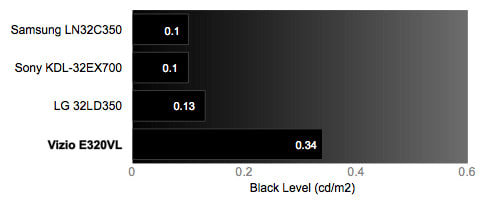
Peak Brightness
{{section_header}}{{section.name}}{{/section_header}}
The peak brightness of the Samsung LN46D550 is not the brightest output we've seen in an LCD, but it's certainly bright enough for most purposes. It is possible that this figure was pulled down by the TV's obligatory dynamic contrast, although the effect should not be as dramatic as in the black level rating. More on how we test peak brightness.
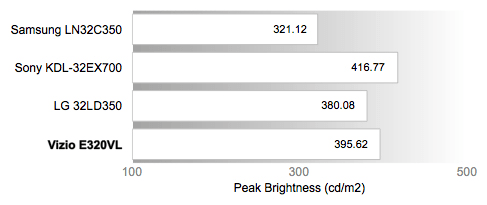
Contrast
{{section_header}}{{section.name}}{{/section_header}}
This HDTV has an excellent contrast ratio—in theory. In practice, however, this figure must be taken with a grain of salt because of the inability to turn off dynamic contrast. The television will always auto-dim to some degree, even if it says this feature is off, so when it sees that it's displaying a dark scene, it will drop the backlight level of the whole screen. The lag time of the processing is briefer than in 2010 models, which is nice. However, since we derive this value from independent black and white readings, the auto-dimming has a major effect on our ability to determine a solid number for contrast. We discuss this further in our assessment of the black level at the top of this page. More on how we test contrast.

Tunnel Contrast
{{section_header}}{{section.name}}{{/section_header}}
We attempted to calibrate the LN46D550 for a Normal HDMI Black Level, but opted not to use these settings because of how much they increased the severity of this problem. You can see the effects of this configuration below and read more about the issue in our Calibration section.

For the tunnel contrast test, we measure the black level of a shrinking black box surrounded by pure white. You can imagine that this television would suffer in this test, since mandatory auto-dimming adjusts its backlight according to how much black and white are on the screen. You can see the effect of the dropping backlight in the graph below. More on how we test tunnel contrast.
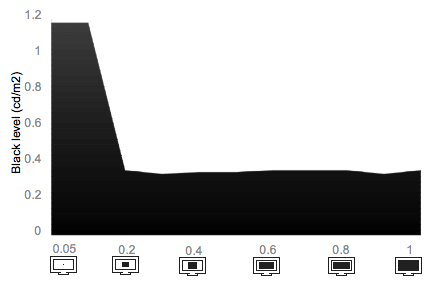
White Falloff
{{section_header}}{{section.name}}{{/section_header}}
As in our tunnel contrast test, this LCD's auto-dimming feature adjusts the backlight according to the percentage of the screen interpreted as dark. Accordingly, the LN46D550 takes a huge hit in our white falloff test. Here, we measure the brightness of an expanding box of white against a background of pitch black. Usually, LCDs don't have a problem with this, but you can see that the dynamic contrast of this Samsung has actually ruined its performance here. More on how we test white falloff.
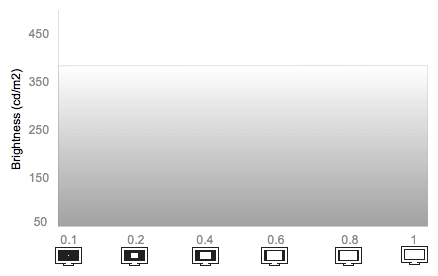
Uniformity
Greyscale Gamma
{{section_header}}{{section.name}}{{/section_header}}
The greyscale performance of this TV was definitely damaged by its dynamic contrast. The line is a little steeper than it ought to be, because the backlight drops along with the source intensity. The tail at the end of the graph means that for very dark blacks, the backlight drops the values into an even darker shade of black. This means that for dark scenes, all dark greys are crushed into black. Since it's mainly a problem of the auto-dimming, you may have better luck spotting shadow details in an otherwise bright scene. You can read more about this issue in our discussion of the black level. More on how we test greyscale gamma.
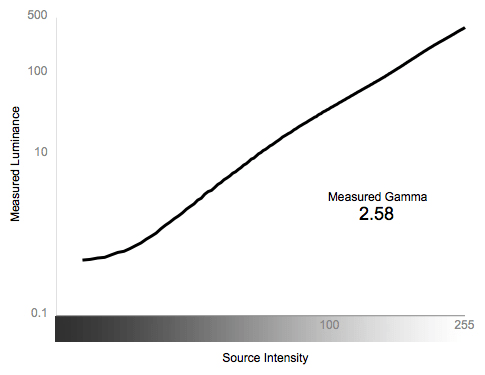
Color Temperature
{{section_header}}{{section.name}}{{/section_header}}
The color temperature of the LN46D550 was great in our tests; it remained within the boundary of human perceptibility for all values but the darkest ones, for which it spiked into blue. For all signal intensities except the darkest, this television will display colors true to a moderate temperature. More on how we test color temperature.

RGB Curves
{{section_header}}{{section.name}}{{/section_header}}
In case you have calibrated your TV for a HDMI Black Level of Normal, we have provided the following alternate RGB curve analysis. (Our alternate calibration can be found in the Calibration section.) This is one of the few areas in which the alternate calibration performed better. The green curve's output matches up with the red one, and while the blue curve still sags into the dark, it's not nearly as bad as it is for the standard calibration.

On the standard calibration, the curves are nice and smooth, but not as bright for green and blue as they are for red. Additionally, there is slight peaking of the red and blue curves. In "all I care about is watching my stories" terms, this means: (1) The glow surrounding the dramatic fireplace will be nice and smooth instead of being surrounded by bands of incrementing color, (2) the very brightest reds of the rose at the comatose lover's bedside will have its details mashed into pure red (although not too severely), and (3) the purple scarf of the other woman may look a bit redder than it should. More on how we test RGB curves.

Because the curves sag below the line that would connect their endpoints, it means all the middle greys are displayed artificially darker than they ought to be. You can see this in the strips below, which have their medium values of red, blue, and green dipping into black very early. You can also see the tiny peak of red and green at the leftmost end. For an example of really bad peaking, take a look at the Panasonic TC-L42U30's red and blue strips.
Motion Performance
{{section_header}}{{section.name}}{{/section_header}}
The motion performance of the Samsung LN46D550 was relatively poor. It had some jittering of moving edges, slight stairstepping which became more prominent in 1080 interlaced resolution, and typical blurring. What struck us as really bad, however, was when we pulled a rectangle across the screen: it skewed into a parallelogram. By the time the processor finished drawing the bottom horizontal line, the box had already moved considerably at the top. More on how we test motion performance.
3:2 Pulldown & 24fps
{{section_header}}{{section.name}}{{/section_header}}
Like most TVs in this class, the LN46D550 has a film mode for improving its 3:2 pulldown processing. High-frequency patterns flickered and sporadically strobed. When we adjusted the film mode from Auto1 to Auto2, the problems more or less disappeared. We noticed a slight mosquito crawl over the seats in a stadium, but it wasn't severe. More on how we test 3:2 pulldown and 24fps.
Resolution Scaling
{{section_header}}{{section.name}}{{/section_header}}
Resolution scaling was good for every format but 480p. For some reason, the Screen Adjustment settings were locked under this resolution, which was forced into overscanning. More on how we test resolution scaling.
480p
Overscan could not be turned off in this setting, which overscanned by 6% vertically and horizontally. Moiré interference and high-frequency patterns displayed fine, but legibility at small fonts was poor.
720p
This resolution did not overscan and did a good job displaying high-frequency patterns. It had minimal issues with legibility.
1080i
This resolution had the same great display of high-frequency patterns with no overscan. It had legibility that was a bit worse than the 720p format, yet not as bad as that of 480p.
Formats
{{section_header}}{{section.name}}{{/section_header}}
The LN46D550 LCD HDTV supports all NTSC-standard formats and has a mode to assist in 3:2 pulldown.
Viewing Angle
{{section_header}}{{section.name}}{{/section_header}}
We were surprised by how bad the LN46D550's viewing angle was in testing. Our spectrophotometer could not make it 12° from center before the contrast dropped below 50%. This translates to a 25° total viewing angle. This is much worse than last year's Samsung LN46C650 LCD. If you expect to have a few people viewing this TV from various angles, we recommend you sit far enough away from it to remain within the narrow angle of optimal contrast.

Reflectance
{{section_header}}{{section.name}}{{/section_header}}
The surface of this LCD was unfortunately reflective. On a white screen, we could make out individual LEDs in an array, which was surrounded by a minor glow. On a black screen, however, the LEDs were surrounded by a huge, white glow and underscored by a cross-shaped rainbow pattern. Any objects in the room illuminated by local sources had their ghostly, glowing reflections cast onto the screen. On videos of middle brightness with a lot of movement, which is what most media consist of, the effect is much more forgiving, especially if the light is angled.
Video Processing
{{section_header}}{{section.name}}{{/section_header}}
The Samsung LN46D550 offers several video processing modes, which you may or may not like. We're of the mind that a TV with perfectly accurate display will convey the director's intentions perfectly. However, since there is no perfect television, these settings might help inch you towards your personal ideal.
Calibration
{{section_header}}{{section.name}}{{/section_header}}
We use DisplayMate calibration software and a spectrophotometer to optimize our TVs for viewing in a dark room. While we feel this is the most controlled method of calibration, your own usage might differ.
For calibration elitists, Samsung provides three additional video modes. RGB Only Mode outputs only red, green, or blue at a time for fine-tuning hue and saturation. White Offset allows you to increment color temperature on six sliders for RGB offsets and gain. Finally, a Color Space mode allows you to set the color space of the TV as either Auto or Native to its media source.
We found the HDMI Black Level setting relatively frustrating. For one thing, Low was actually normal in our calibration, while Normal made everything very bright. Worse, when the Samsung sensed it was receiving cable TV input, it set the level to Normal and then locked the setting.
As a result, we attempted to recalibrate with HDMI Black Level set to Normal_, but it didn’t perform quite as well in color tests when we did this. Regardless, if you mostly watch cable and find the HDMI Black Level locked on *Normal, you could give the alternate calibration below a shot. We’ve posted its alternate test results in our Blacks & Whites and Color sections.
For our final calibration choices, see below.

All of our calibration is done in conjunction with the DisplayMate software.
](http://www.displaymate.com/)
Video Modes
{{section_header}}{{section.name}}{{/section_header}}
There are a few preset video modes available to use as a starting point, but not too many; Samsung seems to understand that having 15 presets is more daunting than useful.
Connectivity
{{section_header}}{{section.name}}{{/section_header}}
The LN46D550 has a decent selection of ports spread between the back corner and a recessed ledge on the side. A quartet of HDMI ports gives you many options, and a couple of shared component/composite ports round out connectivity for older devices.

On the back, most of these ports are clustered in a shallow, metal crater. A VGA port enables you to connect to a computer with ease, and an Ethernet connector offers possibilities limited only by your bandwidth. There is also an EX-LINK port for service.
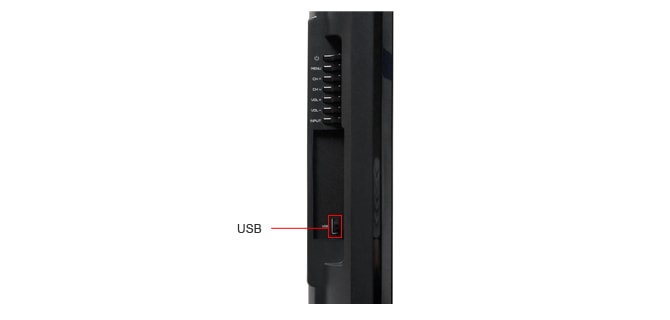
On the side, a couple of USB ports in a recessed ledge allow you to view photos/videos or upgrade software. Their neighbors are a couple HDMI ports, with whom their relationship is strained, but improving.
{{product.manufacturer_specs['Connectivity Tour Image 3']}}
Placement
{{section_header}}{{section.name}}{{/section_header}}
The ports are labeled and placed in a fairly logical configuration. A swivel stand makes it easy to reach them if you need to change your sources.
Audio Quality
{{section_header}}{{section.name}}{{/section_header}}
The audio quality of the LN46D550's two 10-W speakers was very good for a pair of 10-watt television speakers. We always like to use external speakers for the best viewing experience, but this TV's onboard speakers would not be the worst option.

The sound was quite natural, unlike most tinny TV speakers that have a problem with bass. The SRS TruDialog feature we cannot vouch for, as it seemed to give voices a hollow sound. It did set them apart from background noise, though. The SRS TruSurround HD feature, on the other hand, we really liked. It did a good job of emulating a surround sound audio system, and made the bass sound richer. Larger TVs like this have an easier time with this because the speakers are farther apart on the screen. Finally, there are a few presets equalizer settings, but you can also adjust things by frequency on the full-fledged equalizer.
Menu Interface
{{section_header}}{{section.name}}{{/section_header}}
The menu system is mostly the same as last year's interface. Large, animated icons form a column on the left, while their submenus populate to the right. The system is very intuitive and legible, dominated by translucent black. Navigating with the remote is a snap, although the menus are a little laggy.

Submenus take on a different look which consists primarily of grey boxes with blue highlighting rings. It doesn't really feel aesthetically cohesive, but it does get the job done.
One thing we didn't like was that there are so many options in some menus that it takes a while to scroll to a selection with the spongy remote buttons. The categories do wrap, so you can at least scroll up to the last feature in a list. And really, these menus weren't as bloated as some of the televisions we've seen. Those are essentially large, stationary computers that you operate with a remote instead of a keyboard. If that sounds perfectly natural or reasonable to you, you are either: (a) a large, television-manufacturing corporation or (b) crazy.

Instruction Manual
{{section_header}}{{section.name}}{{/section_header}}
Like many modern TVs, the LN46D550 comes with a digital manual that you access from the TV itself. While it's nice that the e-manual is searchable, we wish the manual wasn't white on black. It's a shame that the index is more legible than the document itself.We like that there's a picture-in-picture screen in the corner of the e-manual navigation system.
Thankfully, it also has a downloadable PDF that you can search if you want to read the "The TV will not turn on" entry of the troubleshooting section. Finally, there is a paper manual in the box. Although it is labeled, "User Manual," it is really just a leaflet whose primary educational goal is achieved on its cover by a diagram showing you how to push the E-Manual button on the remote.
You can find the Samsung LN46D550's manual online here.

A manual for so many TV models, they have to be further categorized by type.
Internet Features
{{section_header}}{{section.name}}{{/section_header}}
The LN46D550 does not have any internet features. Its LAN connectivity is used only for for software updates and DLNA.
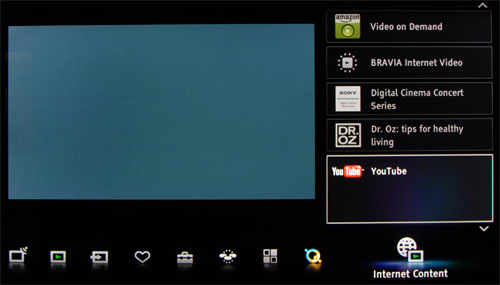
Local Media Playback
{{section_header}}{{section.name}}{{/section_header}}
The LN46D550 has one of the few media playback systems we can imagine a real person voluntarily using. When you insert a USB drive, you're asked if you want to view its files for playback. The media playback system is attractive, intuitive, and will show you all files of a media category. Many codecs of video, photo, and music are supported, plus a few subtitle formats.

You can zoom and rotate photos for viewing, and you can call up their file information. The slideshow feature allows you to adjust photos' time on screen, as well play background music.
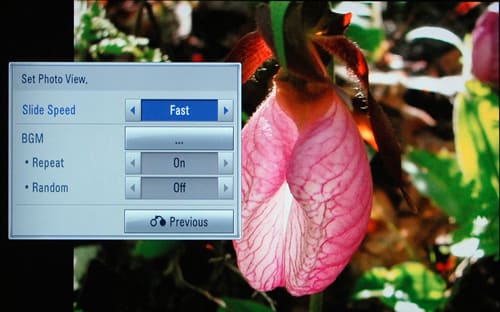
Music playback has a split-screen interface, which shows you song information on the left and a playlist you can navigate on the right. Playback is controlled by playback buttons on the remote, and further tools are available to change repeat or shuffle modes. Video is played through a similar interface with the playback buttons.
One problem with the media playback system is with Digital Rights Management. If try to play an mp3 that you purchased in digital form, its DRM status may make it unplayable by this TV. Another issue is merely a minor hassle: to play video in a DivX format, you must first register the TV at http://vod.divx.com. Because there is no browser, this must be done from a computer, the URL copied off the screen.
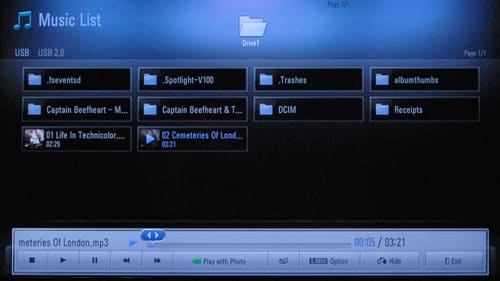
Other Media
{{section_header}}{{section.name}}{{/section_header}}
The Samsung LN46D550 has no built-in media playback devices.
Power Consumption
{{section_header}}{{section.name}}{{/section_header}}
The LN46D550 consumes a typical amount of energy for a 46-inch LCD screen. It and three similarly-sized LCDs all cost around $22 and change to power for a year of TV-watching for five hours daily. This calculation is for a backlight setting of 11, which will achieve the 200 candelas per square meter recommended for viewing in a dark room. Additionally, this Samsung has a Motion Lighting viewing effect, which is a video processing mode for reducing power consumption by motion rendering.
Below, we've gathered three LCDs of around 46 inches for comparison. Their yearly costs don't vary by much.
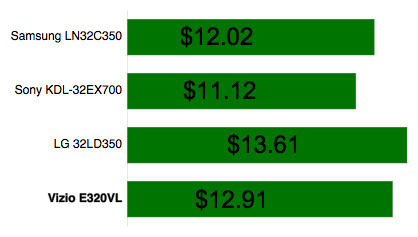
Value Comparison
{{section_header}}{{section.name}}{{/section_header}}
The Samsung LN46D550 has a few quirks, like its dynamic contrast and comically small viewing angle, but overall, we think it's a better buy than the Panasonic TC-L42U30. Sure, it costs about a hundred bucks more, but that's only 12%, and it's based on probably-outdated MSRP. It's got better contrast, better color accuracy, and much better connectivity. Oh, and it's nicer looking.
Blacks & Whites
{{section_header}}{{section.name}}{{/section_header}}
The LN46D550 has a very deep black and a bright peak white, resulting in a contrast. It beats out the Panasonic TC-L42U30 by a significant margin. However, these results cannot be quantified based on numbers alone because of the Samsung's mandatory auto-dimming feature. When a scene cuts quickly from bright to dark, the Samsung will dim its screen a split-second later to accomodate the interpreted dark mood. To read more about this feature, and how it cannot be turned off, but has improved from previous years, see the Blacks & Whites section.

Color Accuracy
{{section_header}}{{section.name}}{{/section_header}}
The Samsung LN46D550 has better color temperature than the Panasonic TC-L42U30, which tends to drift orange. Moreover, the TC-L42U30 has much worse color accuracy, as shown in the curves below. Its blue curve, especially, peaks about 82% of the way towards its brightest shade. If you're concerned about color in your choice of a primarily visual display system, then you would logically conclude that the Samsung is a better bet.
Motion
{{section_header}}{{section.name}}{{/section_header}}
The Samsung and Panasonic had similar motion performance, with the Panasonic rendering things a bit more smoothly overall. It seems that the Samsung has more problems with refreshing the screen smoothly, while the Panasonic has some problems with artifacting and false coloration. The Panasonic is superior in this category, but only by a little.
Viewing Effects
{{section_header}}{{section.name}}{{/section_header}}
Viewing angle is one area in which this Samsung gets crushed. The Panasonic TC-L42U30 has the best viewing angle of these four LCDs, with a total range of 34.5 degrees. If viewing angle is a concern, the LN46D550's total angle of just over 12° should concern you. Of course, if that's true, maybe you should think about getting a plasma instead.
Connectivity
{{section_header}}{{section.name}}{{/section_header}}
The Samsung LN46D550 has much better connectivity than the Panasonic TC-L42U30. It's got more HDMI ports, more than one shared component/composite port, DLNA, and WiFi upgrade possibility. The only thing the Panasonic has more of is in its SD/SDHC card reader, but this really doesn't seem important, especially with the Samsung's DLNA streaming capability.
Other Comparisons
{{section_header}}{{section.name}}{{/section_header}}
If you plan to use the media playback system at all, which the Samsung can stream from your computer via Ethernet, you should know that the LN46D550 has a great interface.
Value Comparison
{{section_header}}{{section.name}}{{/section_header}}
At these price points, there is no way anyone would buy last year's Samsung LN46C650 model over the newer LN46D550. The LN46C650 has a slightly better viewing angle and internet streaming capabilities, but the LN46D550 has had its picture quality improved overall. We think the greatest improvement has been in the decreased lag time of the mandatory dynamic contrast. If you can find the LN46C650 for a cheaper price and internet streaming content beyond DLNA is important to you, it would be a reasonable pick. Overall, though, the newer LN46D550 is a much better value.
Blacks & Whites
{{section_header}}{{section.name}}{{/section_header}}
You might be surprised to see that last year's 46-inch LCD model made by Samsung has better contrast than the 2011 update. While this is not the only the only category in which the LCD has actually gotten worse, it's also an unfair number to judge by. In other comparisons we point out the fact that Samsung has an aggressive auto-dimming feature that cannot be disabled. For a comparison between Samsungs, both of them have this characteristic. However, technology has improved since last year, and the lag time between brightness changes has decreased in the LN46D550 model. Because the contrasts are really very similar, we prefer this newer model. For more information on Samsung's dynamic contrast, see our Blacks & Whites section.

Color Accuracy
{{section_header}}{{section.name}}{{/section_header}}
The color temperature of the Samsung LN46D550 has improved since the LN46C650, which tends to veer considerably into blues. The LN46D550's curves also score a bit higher, but not considerably. They have smoother color gradients, but they don't output at the same levels for red, green, and blue. Due to the significant color temperature difference, we maintain that theLN46D550 is more true to color.
Motion
{{section_header}}{{section.name}}{{/section_header}}
Motion is one area in which the LN46D550 has fallen in performance. Last year's LN46C650 did a fine job of rendering motion, but something about the LN46D550's processing has given it significant problems refreshing at a consistent rate over the entire screen. This is likely due to the LN46C650's 120 Hz refresh rate, while the LN46D550 has the standard 60 Hz rate.
Viewing Effects
{{section_header}}{{section.name}}{{/section_header}}
The viewing angle of the LN46D550 Samsung model is even worse than that of the LN46C650, if you can even believe that. While last year's model had 26° of viewing angle, and we likely thought that was horrible, theLN46D550 only has 12 degrees to its name. Sure, viewing angle is not one of the LN46D550's strong points, but this matchup is downright embarrassing.
Connectivity
{{section_header}}{{section.name}}{{/section_header}}
These two Samsung LCDs have identical connectivity features. The difference is only in how they deal with the internet capabilities they both have.
Other Comparisons
{{section_header}}{{section.name}}{{/section_header}}
The LN46C650 has internet streaming capabilities that were dropped in the LN46D550 model. Perhaps Samsung believes that DLNA is content-streaming enough for a television. Regardless, if content is something you want streamed directly from the internet to your television, you may opt for the LN46C650 model.
Value Comparison
{{section_header}}{{section.name}}{{/section_header}}
The LG 47LD4500 offers an extra inch and marginally better color performance for your hundred dollars. That's essentially the choice here, and we don't think it's worth it. If it weren't for the Samsung LN46D550's superior contrast and connectivity, we might be of a different mind. But as it is, the Samsung is about on the level for color, and it has DLNA support to boot. We think the LN46D550 is a better all-rounder, especially for the lower fixed price.
Blacks & Whites
{{section_header}}{{section.name}}{{/section_header}}
The Samsung LN46D550 has contrast that's tremendously better than that of the LG 47LD4500, whose black level just doesn't get very dark. This doesn't account, however, for the obligatory auto-dimming feature of all Samsungs, which lends itself to a darker pitch black and bright white. That's good for contrast between scenes, but not so much for depicting a close-up of zebras—something that shows bright whites and dark blacks in the same image. Raising or lowering the backlight, which is what Samsung's dynamic contrast is good for, is not going to help achieve better contrast in a frame. Regardless, we do think it has better contrast overall. Check out our Blacks & Whites section for more information on the dynamic contrast.

Color Accuracy
{{section_header}}{{section.name}}{{/section_header}}
It's a close battle for color accuracy: the Samsung has a much better color temperature over the LG, which runs blue for ever middle shade, all the way down to black. The LG has great color curves, though, which are very smooth and uniform. The Samsung's curves have a touch of color banding in their gradients, and the blue curve lags behind the other two. They both peak by a very small amount. Because of the inconsistency in the Samsung's curves, we think the two displays are relatively evenly matched for color accuracy. In fact, despite the LG's cooling tendency, we prefer it for its deeper range of visible blues.
Motion
{{section_header}}{{section.name}}{{/section_header}}
Neither of these HDTVs had great performance in our motion tests. These results are close enough to be considered equal; the Samsung LN46D550 suffered for uniformity, while the LG 47LD4500 had bigger problems with artifacts.
Viewing Effects
{{section_header}}{{section.name}}{{/section_header}}
Viewing angle is not one of this Samsung's strong points, as evinced by these results. The LN46D550 has a total viewing angle of 12° before its contrast drop below an acceptable 50% threshold. The LG performs more like a standard LCD screen with a mid-range angle of 32°. LCD screens, traditionally, do not have great viewing angles compared to plasmas.
Connectivity
{{section_header}}{{section.name}}{{/section_header}}
The Samsung performs much better in the connectivity department than does the LG 47LD4500. It has twice the HDMI ports, plus Ethernet DLNA connectivity and the potential to buy a WiFi dongle for its additional USB port. We don't think an analog audio in ports has the potential to exceed these features in usefulness, although the RS-232C could be useful for screen calibration.
Other Comparisons
{{section_header}}{{section.name}}{{/section_header}}
The Samsung LN46D550 has a more well-designed media playback system that also supports video, in accordance with its DLNA support. If you think you might use that feature, know that the Samsung's interface for media is very usable.
Conclusion
The LN46D550 is a competitive 1080p LCD release by Samsung for this year. At an $899 MSRP, it lacks online streaming, but has DLNA support to go along with its Ethernet port and optional WiFi.
In accordance with Samsung's wishes, it has a Dynamic Contrast auto-dimming feature that cannot be turned off (despite telling you to your face that it is). The lag time of this feature is definitely better than in previous models, though. We still don't like when the devices we spent hundreds of dollars on don't relinquish complete control to their owners. Its contrast is otherwise very good.
Regardless, this TV has great connectivity, a pretty good picture, and a slew of potentially useful features. It's got sharp looks and a swiveling base, plus a well-designed remote and interface that make it pleasant to use. If you can get past its below-average motion rendering and awful viewing angle, this can be a solid HDTV for many purposes.
Model Series Comparison
{{section_header}}{{section.name}}{{/section_header}}
The LNxxD550 series is a group of four LCD HDTV series ranging from 32 to 46 inches in size. They have good options for connectivity, including DLNA support and an optional WiFi adapter. Their media playback capabilities include photos, music, video, and subtitles of many encoding types. They have the mandatory dynamic contrast characteristic of Samsung TVs, but its lag time has improved since previous years. For displays 37 inches and over, Samsung also offers Star Service support.
Photo Gallery
{{photo_gallery "Front Tour Image", "Back Tour Image", "Sides Tour Image", "Stand Photo", "Controls Photo", "Remote Control Photo", "Connectivity Tour Image 1", "Connectivity Tour Image 2", "Connectivity Extra Photo", "Menu Main Photo", "Menu 2 Photo", "Internet Features 1 Photo", "Internet Features 2 Photo", "Internet Features 3 Photo", "Local Media Playback 1 Photo", "Local Media Playback 2 Photo"}}
Ratings & Specs
{{manufacturer_specs_table}}
Meet the tester
Jackie Lee is a valued contributor to the Reviewed.com family of sites.
Checking our work.
Our team is here to help you buy the best stuff and love what you own. Our writers, editors, and experts obsess over the products we cover to make sure you're confident and satisfied. Have a different opinion about something we recommend? Email us and we'll compare notes.
Shoot us an email